LAST EDITED ON Mar-30-16 AT 11:39 PM (EDT)
This week on Gun of the Week, it's one of the longest-serving and most widely employed military service rifles of the 20th century, the British Lee-Enfield.
Specifically, the example we'll be discussing here today is a .303-Calibre Rifle, Short, Magazine, Lee-Enfield Mark III*, later retroactively redesignated Rifle No. 1 Mk III*. (As we have previously discussed, the asterisk is a revision indicator, denoting that this is an improved version of the Mk III, but not so improved that it was deemed different enough to be designated Mk IV.)
If we take apart the long-winded British ordnance designation, some of the details of this rifle's design and evolution come into focus. Starting at the end, Enfield indicates that the design originated at the Royal Small Arms Factory in the London borough of Enfield (in official parlance, RSAF Enfield Lock, after the nearby lock on the River Lee canal), while Lee has nothing to do with the river, but is in fact the name of the action's designer, James Paris Lee (1831-1904). Lee was a Canadian arms designer who invented the detachable box magazine, the system by which virtually all semi- and fully automatic small arms are supplied with ammunition nowadays. In the late 1800s this was still a noteworthy innovation, which is why the British government felt it necessary to specify that the Lee-Enfield is a Magazine rifle. More on this later.
The Short comes from the fact that the SMLE's 25-inch barrel is five inches shorter than the one fitted to the original Magazine Lee-Enfield rifle. Military rifles had a tendency to get shorter and shorter over the course of the late 19th and early 20th centuries, as infantry tactics evolved and people began to realize that the common soldier's rifle really did not need to be long enough to function as a full-length pike with its bayonet fitted. (That was the original purpose of the bayonet; before that, riflemen were protected from charging cavalry by other men standing next to them with pikes.) The usual practice was for arsenals to produce two versions of a given service rifle: a very long one for the infantry and a very short one for use as a cavalry carbine. The SMLE, introduced in 1904, was an attempt to split the difference: it's about halfway between the original long MLE and the 21-inch carbine version. This simplifies logistics, as your army now can standardize on the one rifle for everyone; the British were not the only ones to do this at around this same time.
The heart of the SMLE, the Lee bolt action, originally debuted in 1888 on the Rifle, Magazine, Lee-Metford. This was the last British army rifle designed for black powder (the original form of gunpowder), and featured a cleverly designed rifling system intended to reduce fouling from powder residue (developed by one William Metford, hence Lee-Metford). The MLM had a short service life, not because there was anything wrong with it, but because the much-improved nitrocellulose-based "smokeless" propellants were developed almost as soon as it entered service. These much cleaner-burning, much more powerful propellants made Metford's fancy anti-fouling rifling unnecessary, and in fact smokeless .303 cartridges didn't work well with it; their much higher velocities wore out MLM barrels in extremely short order.
Thus, in 1895 the Rifle, Magazine, Lee-Enfield took its place. This had essentially the same action, but with a barrel designed to play to the strengths of the new smokeless cartridge. The Short MLE came along in 1904, not long before James Lee died, and the definitive Mk III version followed in 1907. The Mk III* was developed during World War I to simplify and speed up production for wartime use, and was adopted in 1915. Hordes and hordes of these were made, not only for the British army, but also for Commonwealth armies in Australia, New Zealand, India, and (once the débâcle of the Ross rifle played itself out in 1916) Canada. Further revisions of the basic design would be developed over the next few decades. The official standard British rifle for most of World War II was the Lee-Enfield No. 4 (the SMLE having been retroactively designated No. 1 in 1926), which was basically the No. 1 Mk III* with still further manufacturing simplifications, but the Mk III* remained the standard rifle in Commonwealth forces until the FN FAL (L1A1) battle rifle came along in the late '50s. Lee-Enfields in various guises can still be found all over the world, many of them in official inventories of one kind or another.
So much for the history lesson; let's take a closer look at this particular one. My SMLE is one of a pair that my grandfather had; he had one in the original .303 British caliber, and one that had been converted after World War II to 7.62x51mm NATO (which is roughly the same cartridge as .308 Winchester). A few years ago, he gave me the .303 one, which is the one we're looking at here.
In the overall picture at the top of this article, you'll notice that the rifle is wearing an action cover. This is a genuine surplus item a friend tracked down online for me:
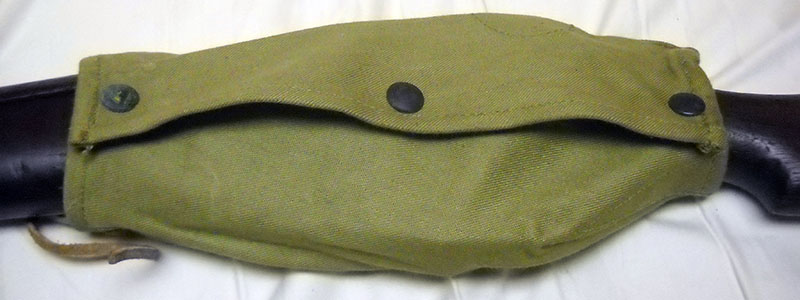
Notice the tarnish on the snaps. This sat in an arsenal for decades, unremarked, before being bought up by some surplus company somewhere and eventually made available on the Internet. Obviously you can't operate the rifle with the cover in place; it's meant to protect the action on, for example, long marches, or during other out-of-combat transit.
Underneath that cover, the action looks like this.
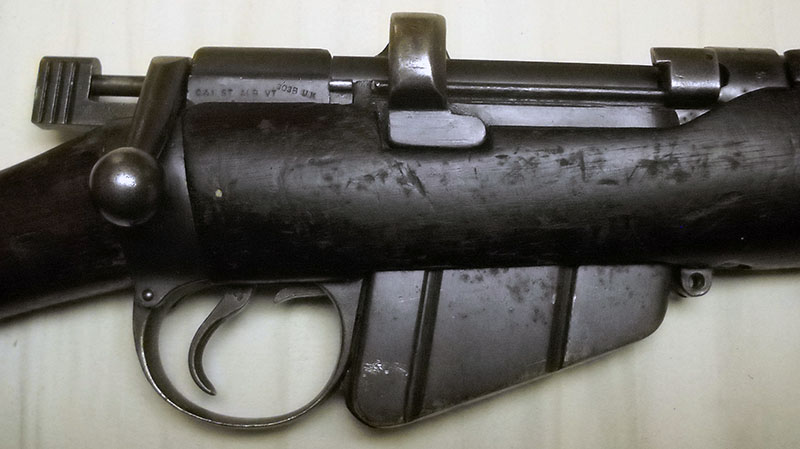
The SMLE is a bolt-action rifle, meaning that to operate it, you have to rotate the bolt by turning that ball-ended handle upward, then pull it back to open the action and extract/eject the spent cartridge case.
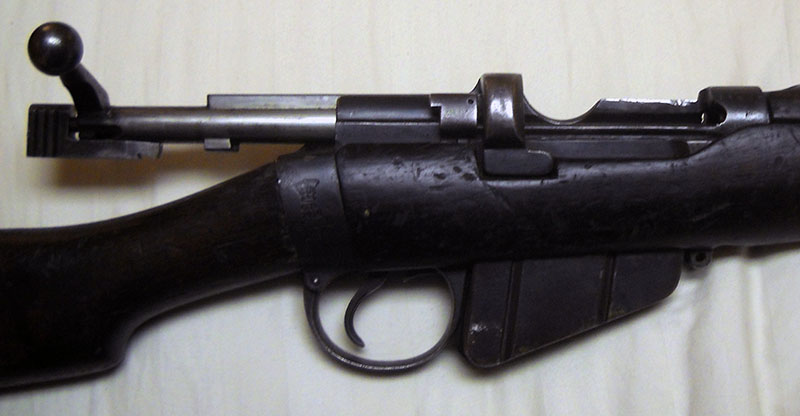
Of note is that the Lee action is a cock-on-close system, meaning that the spring-loaded striker is cocked for firing by the act of pushing the bolt shut (which strips the next round out of the magazine and chambers it) and locking it. This is as opposed to a cock-on-open system, where the act of unlocking the bolt and pulling it back does the work of cocking the striker. The Lee-Enfield's contemporaries, the German Mauser Gw 98 and Russian Mosin-Nagant, are both cock-on-open designs. Basically, the operational difference comes down to which of the operations requires more force than the other (and how much engineering has to be applied to minimize the difference). Some shooters prefer the cock-on-close system because it makes the opening operation faster and smoother, and they feel that applying more force to close the bolt than to open it is more natural and intuitive. There is also a long-standing belief in some circles that the Lee-Enfield action is faster than its competitors specifically because it's cock-on-close.
It should also be noted here that, in well-trained hands, the Lee-Enfield is a shockingly rapid-firing bolt-action rifle. There are accounts of German troops early in World War I who believed that they had come under machine gun attack, when in fact it was just that the British units opposing them were laying down that great a volume of coordinated rifle fire. British doctrine at the time put very heavy stress on marksmanship and coordination; though small by the standards of the day, the British Expeditionary Force at the start of the war was by far the best-trained, best-equipped army in the world. For all that the Germans are stereotyped as professional soldiers, their army was mostly generically-trained conscripts; not so the BEF in 1914.
As an aside, you'll note that there's a set of markings on the right side of the rifle's wrist band, revealed when the bolt handle is lifted out of the way. One nice thing about military weapons, particularly from the early 20th century, is that they tend to have unambiguous markings:
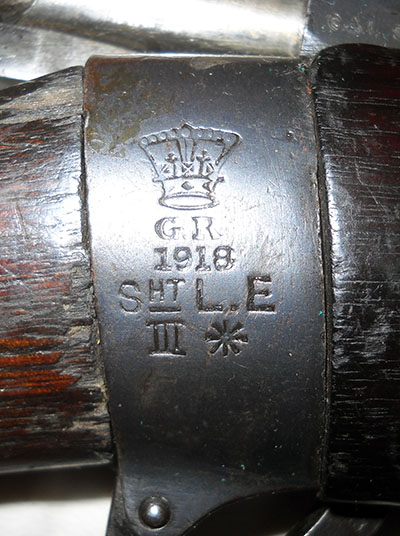
No uncertainty here. This is a Short Magazine Lee-Enfield Mk III*, manufactured for His Majesty George V's armies (G.R. = Georgius Rex, Latin for King George) in 1918, the final year of the Great War. It doesn't specify where it was made, which I thought meant it came from Enfield Lock and not one of the other arsenals and private companies (RSAF Sparkbrook, Birmingham Small Arms Ltd., et al.) that were contracted to augment Enfield's production capacity during the war, but turns out to be something a bit more complicated. Since this item was originally released, information has come to light indicating that SMLEs marked in this way were assembled at Enfield Lock, but from parts made by a variety of subcontractors. This one's receiver seems to have come from the Standard Small Arms Factory in Birmingham. Caliber is not specified here because at the time, all British service rifles were in .303, so it was not considered necessary to say so.
Also visible in the right-side shots above are the importer's markings, on the right side of the receiver just in front of the wrist band. These are somewhat less grand than the original manufacture markings.
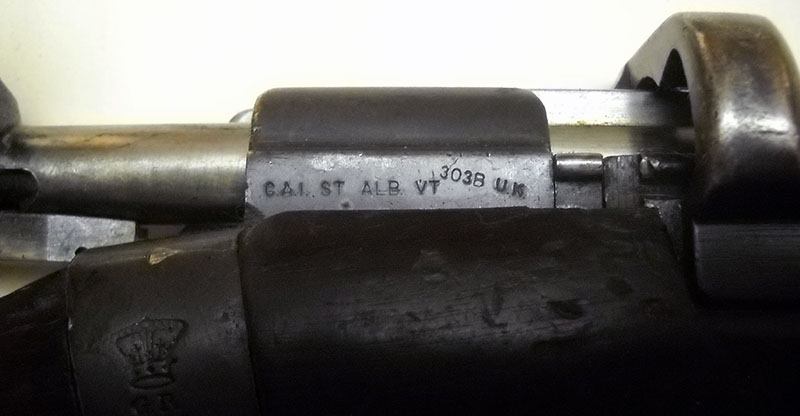
Remember I mentioned in an earlier item that, after 1968, dealers importing firearms from abroad have been required by U.S. federal law to deface them? This is the kind of thing I meant. It does contain all the information required by law, more or less—if you know what you're looking for, as a federal inspector presumably would, you can see from here that this rifle was imported by the Century Arms International company (sometimes also referred to, by itself, as Century International Arms or just Century Arms) of St. Albans, Vermont; that it is chambered for .303 British; and that it was originally made in the United Kingdom.
In fairness, I should say that CAI/CIA/CA has gotten better at marking at least some of its imports since these days, and that this is actually not the most half-assed-looking set of importer's marks I've seen from this particular importer. The CZ 82 pistol I used to have, which was also a CAI import of a surplused European military firearm, looked like its importer's marks were applied with an automated version one of those "tattoo gun converted to mark metal" things. Dot-matrix printing by peening up the surface of the metal. Truly tragic. These were at least made with a real set of letter/number stamps, even if they were just kind of crammed in wherever on the chosen surface they would fit.
While we're on the subject of markings, this SMLE also has a brass unit disc on the buttstock, which was a traditional British thing up until the end of World War I, but I have so far been unable to identify what unit it denotes.
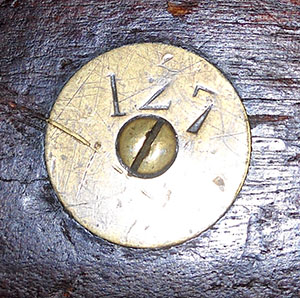
Anyway, let's take a look at the other side of the SMLE action.
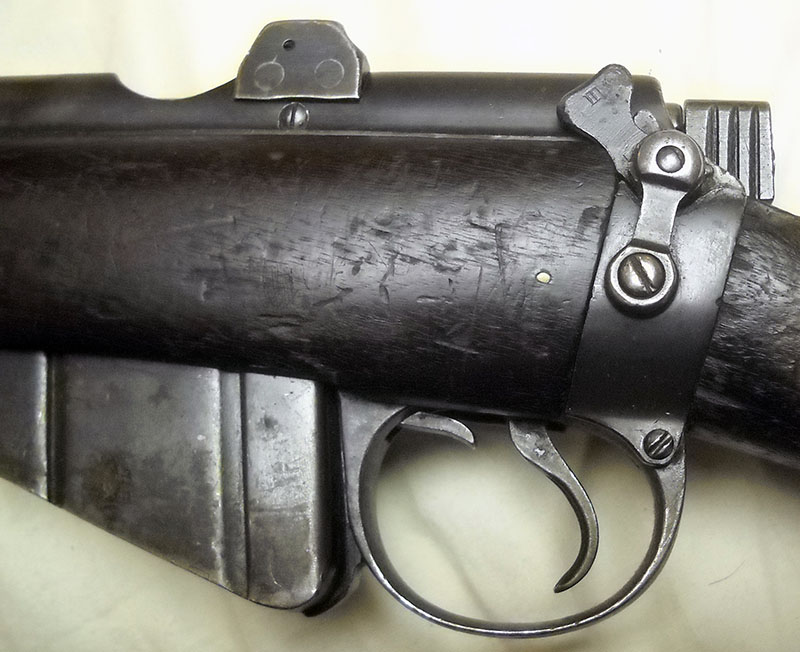
Not as much to see over here, since most of the detail is going on over on the righthand side. Most notable on the left side is the safety lever, which can be seen in the upper right (marked III* just for good measure). Forward (as shown) is Fire, back and down is Safe. If you look carefully you can just see the ridge in the wristband where the lever stops when it's all the way back. The slotted metal tab visible at the right is the cocking knob. This is cocked automatically when the action is worked, as described above, but can also be grasped and pulled back manually if, for instance, you have a dud round and you want to give it another whack with the striker rather than immediately discard it and move on to the next one. (You can also grab it with one hand and pull the trigger with the other to let it down gently rather than dry-fire, but should not attempt to decock the rifle this way with a chambered round, for obvious reasons.)
That structure you can see at the top is not the rear sight, it's just part of the action. The rear sight is actually mounted in front of the action and is not visible in this shot, but let's have a closer look at that because it's interesting.
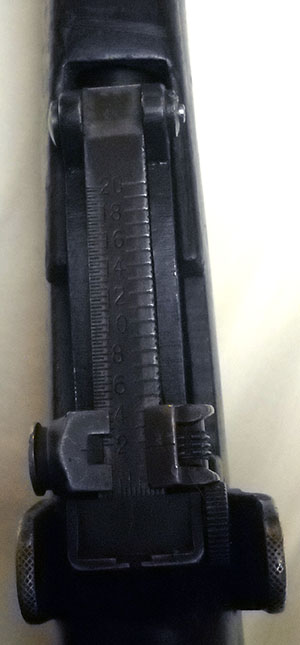
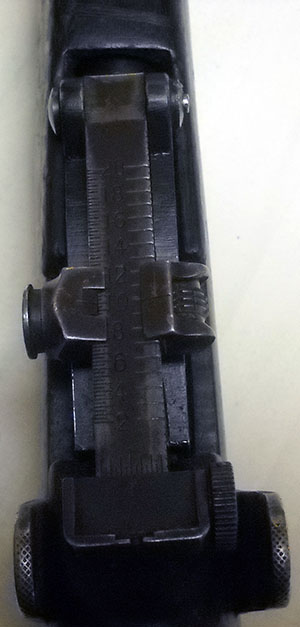
Here are two views of the SMLE's rear sight, seen from above. This is a form of rear sight that was very common on military firearms of the period, called a tangent sight. It's hard to see in these photos, for which I apologize, but it's marked in range increments; in this case, the markings show ranges in increments of 100 yards, from 200 out to 2,000(!). You can see in these photos that there is an adjustable slider on the sight; you press the button on the left side and can then move it backward and forward. What that does is not immediately apparent in the top view, but you can see it clearly from the side:
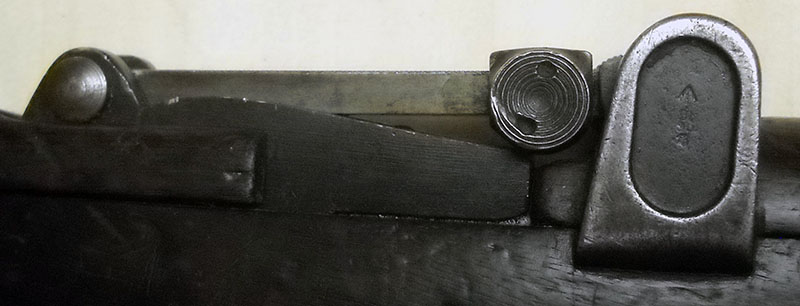
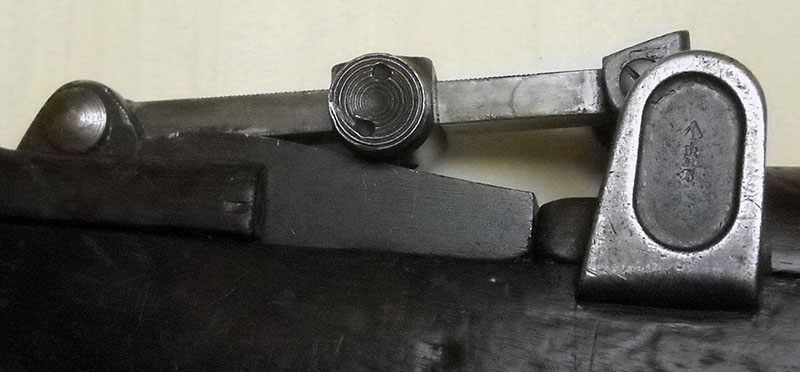
As you see here, moving the sight adjuster forward (i.e., setting it to a longer range) moves the rear sight upward. This forces the shooter to raise the muzzle in order to maintain the correct sight picture on the target, and that—if the shooter has correctly estimated the range, and if the rifle is properly zeroed—compensates for the natural, gravity-induced drop of the bullet at longer ranges.
If the maximum range to which this particular tangent sight can be set strikes you as ludicrously optimistic, that's because it is. Early-20th-century range-adjustable sights often are, in much the same way that the analog speedometers in most automobiles can show speeds which the cars to which they're fitted obviously can't possibly achieve. Even soldiers rigorously drilled in marksmanship, like the BEF early in World War I, cannot realistically be expected to hit a man-sized target with an open-sighted rifle at two thousand yards—that's more than a mile. Most people, I'll wager, can't even see a man-sized target at two thousand yards. It represents more of a Platonic ideal than a realistic expectation.
(As noted in the article about the StG 44 reproduction, most infantry soldiers don't even need a rifle that can shoot anything like as far as that, which was not something that was really taken on board by military strategists and planners until after World War II; in some cases, long after World War II. But that's another show.)
Also of interest in these photos is the marking on the left side of the rear sight's guard (the upright tab visible at the right of the photo). That's an inspector's mark, an indication that the rifle has been tested and accepted for military service. The triangular bit at the top is the "broad arrow", the traditional British service acceptance mark, and the markings below it denote which inspector gave it the OK and where. It's the military rifle equivalent of INSPECTED BY 23.
Taking a close look at an SMLE provides an excellent opportunity to talk about a commonly mistaken bit of firearms terminology, the technical difference between a magazine and a clip. This is because, unusually, the SMLE uses both at the same time.
In small-arms terms, magazine simply refers to the part of a repeating firearm that holds the ammunition before it's chambered. (Incidentally, this is why revolvers don't have magazines even though they're repeaters; each round in a revolver is in its own separate chamber, and is fired from there, not moved into position from a separate holding area.) As mentioned above, James Paris Lee was the inventor of the detachable box magazine, so it's no surprise that the Magazine Lee-Enfield rifle has one:
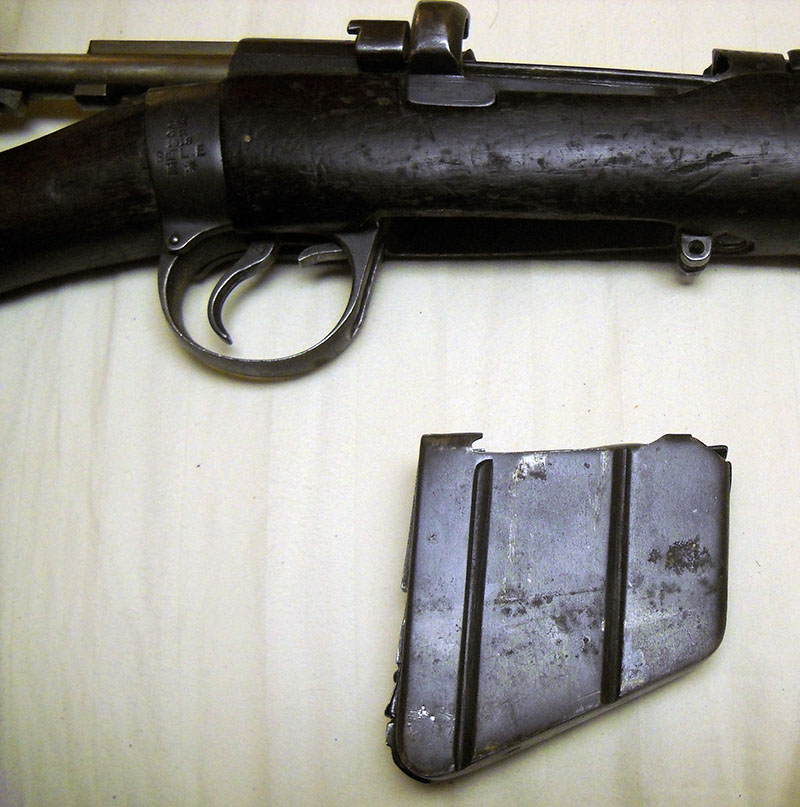
Press upward on that tab inside the trigger guard, in front of the trigger, and out it comes. From the modern perspective, what happens next is obvious: You put however many rounds the magazine holds (in this case, 10) into it, pop it back into the rifle, close the bolt to chamber your first round, and you're off. When you run out, take the magazine out, slap another loaded on in, and carry on. Right?
Wrong!
That was Lee's idea, but the British military authorities had other plans. To understand why requires some knowledge of the typical British officer's attitude toward the common soldiers under his command around the turn of the 20th century. At that time, and for a very long time before then, British army officers tended to regard their men as not much smarter than dogs, and a good deal less trustworthy. Class distinctions in British society at the time operated on a level that isn't easy to picture nowadays, and in those days, officers were gentlemen and common soldiers were... well, not quite entirely human.
As such, they were certainly not fit to be trusted with anything more than they absolutely had to be given in order to function. It was bad enough the army lavished these expensive rifles, bayonets, uniforms and so forth on them, but there was no way the army was ever going to trust them to keep track of more than one magazine. They were surprisingly valuable back then, because they were non-trivially complicated to manufacture and had to be made to fairly exacting standards in order to work properly. If you gave the ordinary soldier more than one of these things, the logic at the time went, he would just lose it. Or sell it, trade it for whores and/or drink, or what have you. So each MLE and SMLE was issued with one (1) and only one (1) magazine, completely negating Lee's point in developing the damn things in the first place.
So how do you load an SMLE? Are you expected to take the magazine out of it and thumb the rounds into it one at a time, as you would to prepare your mags for the day's work back in the rear if you had more than one, only you have to do it under fire? No, absolutely not. For one thing, you're expressly forbidden to remove the magazine from the rifle unless you have to in order to clean it. For another, not even a British general was quite so disconnected from reality as to expect that that would ever work in practice.
Instead, you do exactly the same as the guys are doing on the other side of no man's land—the Boche, whose Mauser rifles are equipped with the system James Paris Lee invented the box magazine to replace. You use clips.
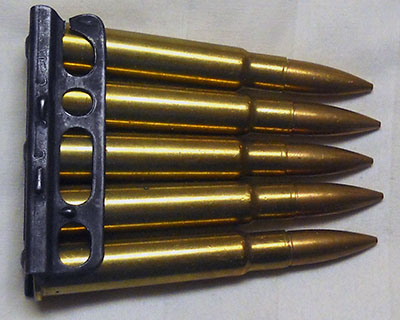
Here is a clip, or "charger", of five .303 British rounds, ready to be loaded into a Lee-Enfield rifle. The clip is just a bit of particularly bent sheet metal, designed to hold the cartridges in place relative to each other, so they can be more speedily applied. As you can see, it's not symmetrical, but that's just an artifact of the way they're manufactured; in practice, if you load them correctly (and in service, they would have come loaded from the arsenal; on the front line, you would be issued clips already loaded, just taken out of the box they came in by the quartermaster and handed out), they can be put into the gun either way up.
What you do, then, is open the bolt (in action, it most likely will already be open from when you ejected the last empty from the previous contingent), line up the clip with a guide machined into the action, and slot it into the rifle, like this:
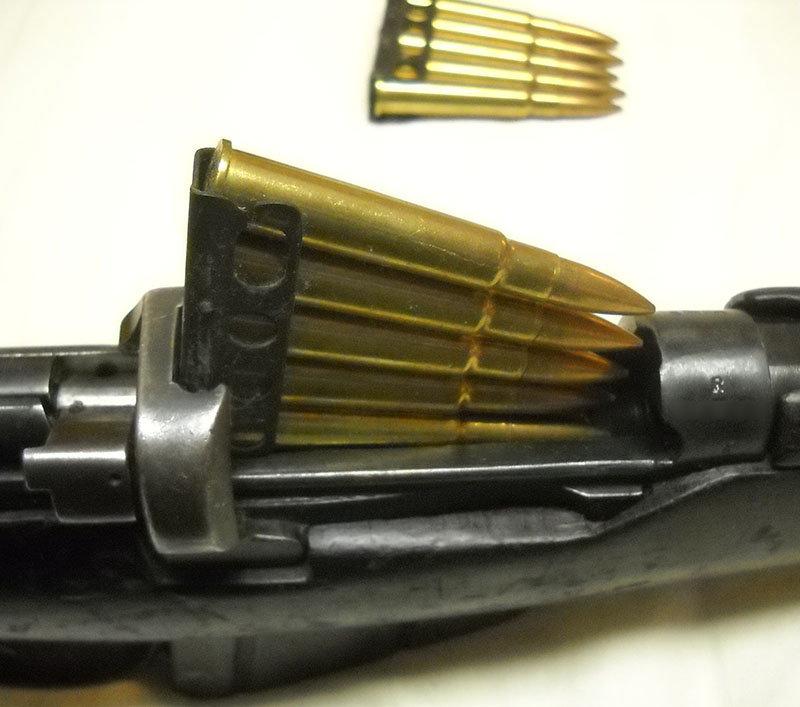
Then you get your thumb onto the top round and shove 'em all down in there. (This is referred to as stripping the clip, and is why this kind of charger is often called a stripper clip.) The clip stays where it is, sticking out of the guide, and when all the rounds are in the magazine, you take it out and throw it away. The SMLE holds 10 rounds, and to keep the clips manageable, they only hold five, so to fully reload you do that twice. The second time, you don't even have to take the empty clip out if you don't feel like it. The act of closing the bolt to chamber your first round will pop it out of the guide and toss it aside.
This system (sometimes called the "Mannlicher style" after its developer, Austrian arms designer Ferdinand Mannlicher) was quite common at the time, and remained in use for quite a while afterward. As noted above, the German Gewehr 98 and its variants all used it; so did the Mosin-Nagant, and the Italian Carcano rifle. A number of early semiautomatic handguns were similarly charged, including the Mauser C96 Broomhandle and the Austrian Roth-Steyr and 1912 Steyr (the so-called "Steyr Hahn") pistols. The Remington Model 8, an early commercial semiauto rifle designed by John Browning, used stripper clips, and because they were considered disposable they are ridiculously hard to find now, though the rifles themselves remain popular with sportsmen.
Even after the British attitude toward ordinary soldiers thawed a bit between the World Wars, the SMLE remained primarily stripper-charged, simply because by then the training and logistics for running them that way were fully entrenched. I wouldn't be at all surprised to learn, however, that some British riflemen made a habit of scavenging extra magazines whenever possible and stashing them away for a rainy day, because what a pain in the ass.
Let's see, what else... oh yes, the bayonet. Mine is a 12-inch Pattern 1903 bayonet, the first type developed for the SMLE (to replace the great honking sword bayonet issued with the long MLE). Actually, it's a cheap modern repro of a Pattern 1903, not the genuine article, but it serves the purpose. Here's a closeup of the left side of the rifle's bayonet mount, which is where the action is (no pun intended).
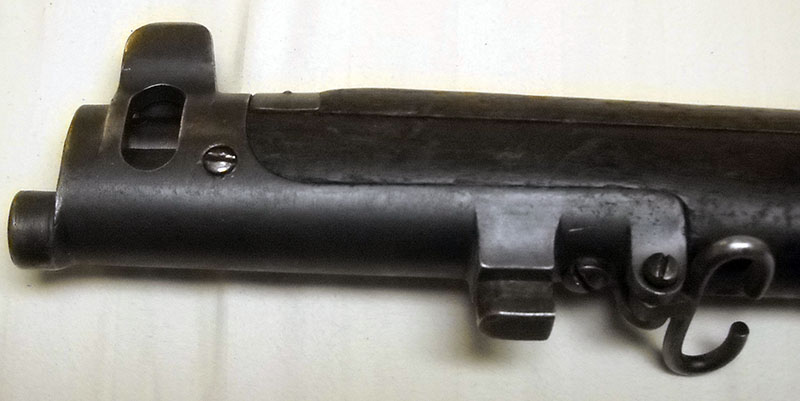
There are two lugs, the main one for mounting underneath and the round one at the front to align the blade parallel to the bore. (That's not the muzzle; the barrel is above it and does not protrude past the nose cap. Also note the big protective flange on the front sight, which helps keep the sight blade from getting bent in the field.)
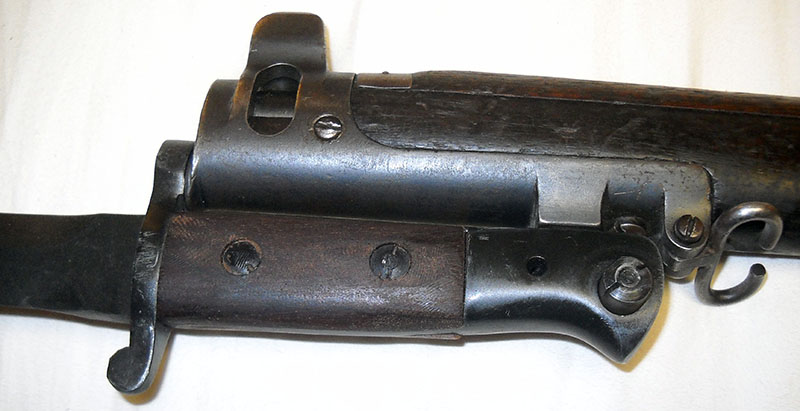
Here you see how it works: The bayonet has a slot machined into its butt and a spring-loaded lock button, and the crossguard has a ring that slips over the alignment lug at the front.
Funnily enough, the Pattern 1903 bayonet was considered too short when it debuted, because military thinkers still assumed that the combined length of rifle and bayonet needed to be long enough to engage a cavalryman. It was therefore replaced by the Pattern 1907, which was similar but had a 17-inch blade instead of the 1903's 12-incher. This is mildly ironic given that cavalry were pretty conclusively shown to be of no military value in WWI, and so functionally speaking, the 1903 bayonet would have been fine for any practical purpose; but that's hindsight talking.
Another unusual thing that can be seen in this photo is that bit of swivel-mounted bent wire just behind the bayonet lug. That's not a sling swivel; they're mounted farther back on the SMLE, and are closed loops. The open one at the very front is a stacking hook. The idea was that if you and two other guys stood your SMLEs butt-down on the ground and leaned them toward each other, you could interlock those hooks on your three rifles and they would form a tripod, mutually keeping each other from falling over and getting mud in their actions. This was considered handy, for instance, at mealtimes, or when sleeping.
In practice, though, it was tricky to unhook them in a hurry, which soldiers found they often had to do, and other ways were found to try and keep the rifles clean. Stacking hooks were phased out of production toward the end of World War I; after the war, they were eliminated altogether, and in fact British armorers were instructed to remove the hooks from existing rifles when they came in for repair or to be placed in storage. The fact that this 1918 rifle a) was still fitted with one and b) didn't lose it after the war is interesting, at least to me.
One more interesting detail: this rifle's buttstock still has its original brass butt plate, and in that plate is a very finely machined little spring-loaded hatch.
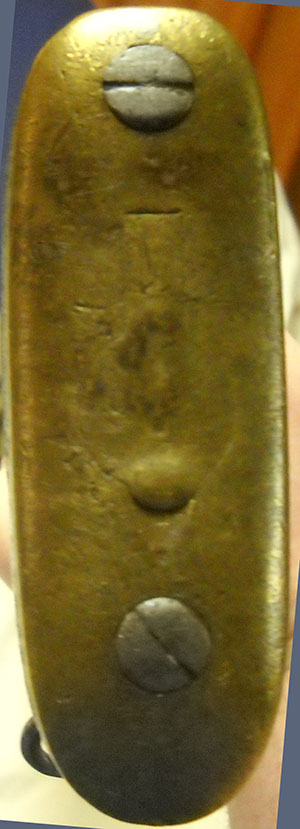
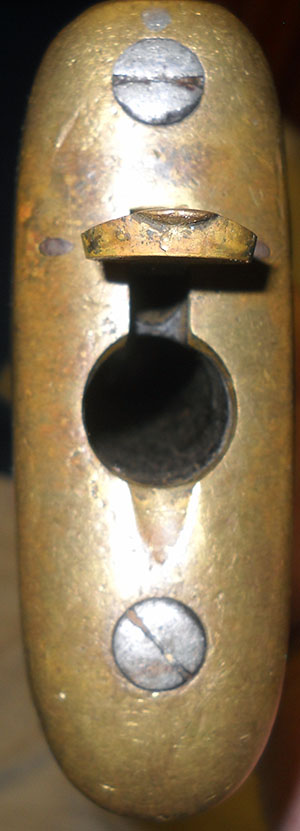
I'm not 100% certain what goes in there. Many older muzzleloading rifles had a similar thing called a patch box, which, as the name suggests, was where you kept a supply of cloth patches to put between powder and ball. I think it may be intended to house a small bottle of oil for maintenance purposes; other British military rifles of my knowledge (such as the Boys anti-tank rifle, of Strike Witches fame) are so equipped. As you can see, mine doesn't have anything in it.
So there we are; another week, another Gun of the Week. I've only scratched the surface of the history and variation of this long-serving rifle; like the Gw 98 and the Mosin-Nagant, the Lee-Enfield action entered service in the 1890s, served major armies through both World Wars, and is still in widespread second- and third-level service today, as well as being widely used and popular on the civilian market. I have a Mosin-Nagant that will probably turn up in its own article at some point; no Mauser, as yet, but that may change.
Next time: something completely different.
--G.


















